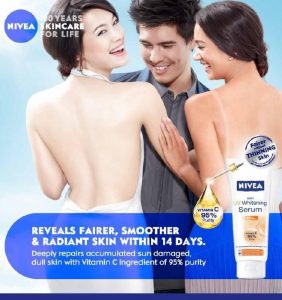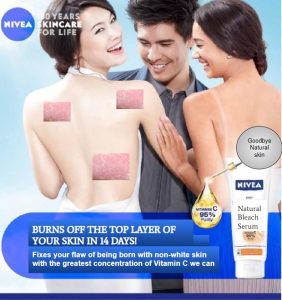
In Asia, beauty standards for women often deem paler skin more beautiful. Even though depending on the country, levels of pigmentation vary greatly, they all look towards pale skin as the ideal. It is not because they wish to be like the Westerners, like many believe, but because historically paler skin means less time working outdoors. This paleness would then signify status in society. This beauty standard has still continued despite the changes in society. This can lead to dangerous actions taken by women who wish to be seen as beautiful by society. Skin bleaching creams and bleaching injections are offered commonly throughout the cities despite the health risks involved. In the CNN article “Skin whiteners are still in demand, despite health concerns,” by Marian Liu (2018), female students get bullied for being naturally born with darker skin in school. They have even found creams that contain mercury and other harmful ingredients that could hurt newborn babies, and cause liver and kidney damage (Engler, 2005).
In this ad specifically, Nivea is trying to promote a UV Whitening serum that whitens skin under the guise of it helping with skin that is damaged by the sun. To begin, suggesting that tanning as a negative and instantly considered sun damaged is an issue. Some amount of sunlight is healthy and Asia has a shocking number of cases of patients with Vitamin D deficiencies due to lack of exposure to the sun. To continue, the models on the poster suggest that the paler model is more attractive. She is both more attractive towards the man and the other woman. This says that not only will having paler skin get her more male attention, but also that other women should strive to be like her. The model with the slightly more tanned skin tone is left without anyone to look at her. This product is clearly marketed towards women and hopes to convince women to buy the product by promising the user both idolization from other women and to be seen as more attractive by the opposite sex.

Here is an edited version of that same Nivea advertisement with a positive message. The main purpose of serum is to nourish and hydrate the users skin, not to bleach. All texts in the advertisement have been edited to reflect the main purpose of a serum, hydration and nourishment, regardless of what colour or shade the user’s skin tone may be. The models in the background have been changed as well. Instead of the paler model being the only one getting attention, now the model with the more tanned skin tone also gets attention, and from the famous Korean actor, Hyun Bin, no less. (Under the assumption that the model on the far right is heterosexual) This way, the advertisement no longer has the main theme of whiter skin being superior to tanned skin. Now both women are admired, regardless of how pale or tan their skin is. The serum thus now just encourages beautiful, healthy skin, regardless of colour. I know the assignment was to highlight the absurdity, but I wanted to have a more positive message. The correctly jammed advertisement is below.

To highlight the absurdity of the product’s advertisement, I changed the wording to “Burns off the top layer of your skin in 14 days! Fixes your flaw of being born with non-white skin with the greatest concentration of Vitamin C we can.” This brings the message the original advertisement was trying to say in a more subtle way to the forefront. A message along the lines of “One’s natural skin tone is not beautiful because it is not white.” The patches of chemical burn on the paler model emphasize the dangers of skin bleaching. (Patches are poorly edited on purpose as well edited one required NSFW warning.) The product name has also been changed to “Natural bleach serum,” as is what the product is trying to market itself as. Vitamin C does reduce hyper-pigmentation, but the way this product was advertised was not simply for the purpose of reducing hyper-pigmentation. The product was meant to make women feel uncomfortable in their own skin and the altered texts say it outright.
With these two versions, I hope to encourage viewers to love the skin that they’re in, regardless of skin tone or shade. One advertisement being how the product should have been marketed, and the other to emphasize the pure absurdity of the original.
References:
Engler, D. E. (2005). Mercury “bleaching” creams. Journal of the American Academy of Dermatology, 52(6), 1113-1114. Retrieved from: sciencedirect.com
“Skin Whiteners Are Still in Demand, despite Health Concerns.” CNN, 2 Sept. 2018, https://www.cnn.com/2018/09/02/health/skin-whitening-lightening-asia-intl/index.html.